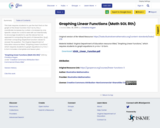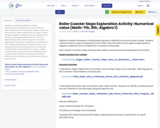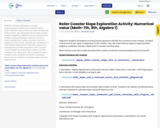
Graph of a Linear Function Algebra Readiness Formative Assessment
- Subject:
- Mathematics
- Material Type:
- Assessment
- Provider:
- VDOE
- Author:
- VDOE
- Date Added:
- 10/07/2024

Graph of a Linear Function Algebra Readiness Formative Assessment

Identifying Slope and Y-intercept Algebra Readiness Remediation Plan

Slope and y-intercept Mathematics Instructional Plan

This task requires students to use the fact that on the graph of the linear function h(x)=ax+b, the y-coordinate increases by a when x increases by one. Specific values for a and b were left out intentionally to encourage students to use the above fact as opposed to computing the point of intersection, (p,q), and then computing respective function values to answer the question. The Virginia Department of Education resource titled, "Graphing Linear Functions," which requires students to graph equations in y=mx + b form includes a template and lesson plan.

This lesson integrates computer science through discovering graphing on a coordinate plane for 6th graders all the way to a review for 8th graders with extensions that include slope.

Students will explore the "story" that can be interpreted from graphs. Graphical representations can be created by looking at videos of different situations on Desmos. After noticing that all types of linear slopes (zero, positive, and negative) can be included in a given situation, students create a graphical representation to show a change in heart rate overtime.

In this task, we are given the graph of two lines including the coordinates of the intersection point and the coordinates of the two vertical intercepts, and are asked for the corresponding equations of the lines. It is a very straightforward task that connects graphs and equations and solutions and intersection points. The students will use a VDOE resource to recognize and describe the graph of a linear function (foldables, bingo game, lesson plan for the teacher).

Just in Time Quick Check Slope

8.16e Matching Representations Co-Teaching MIP

Students will find helpful resources for learning and practicing math skills and processes in this eMediaVA collection.

This collection has resources organized by grade level teachers can use to teach math.

Objective: Students will explore counting boxes/squares to identify the numerical value of slope. Students must know the four types of slope prior to this activity. They will review the four types of slope (positive, negative, undefined, and zero slope) prior to visually counting slope.Note: Teacher must find a video showing roller coaster movement and have prepared for this activity.
The Extension activities are a VDOE Virginia Department of Education Slope and y-intercept resource with bingo game, link to teacher-made foldable, and lesson plan as well as a Drexel University mini- lesson plan with an additional roller coaster activity. Students can identify coordinate points and use materials to calculate slope using the slope formula.

Objective: Students will explore counting boxes/squares to identify the numerical value of slope. Students must know the four types of slope prior to this activity. They will review the four types of slope (positive, negative, undefined, and zero slope) prior to visually counting slope.Note: Teacher must find a video showing roller coaster movement and have prepared for this activity.
The Extension activities are a VDOE Virginia Department of Education Slope and y-intercept resource with bingo game, link to teacher-made foldable, and lesson plan as well as a Drexel University mini- lesson plan with an additional roller coaster activity. Students can identify coordinate points and use materials to calculate slope using the slope formula.

Recognize and describe the graph of a linear function.Mathematics Instructional Plans (MIPs) help teachers align instruction with the Mathematics Standards of Learning (SOL) by providing examples of how the knowledge, skills and processes found in the SOL and curriculum framework can be presented to students in the classroom.